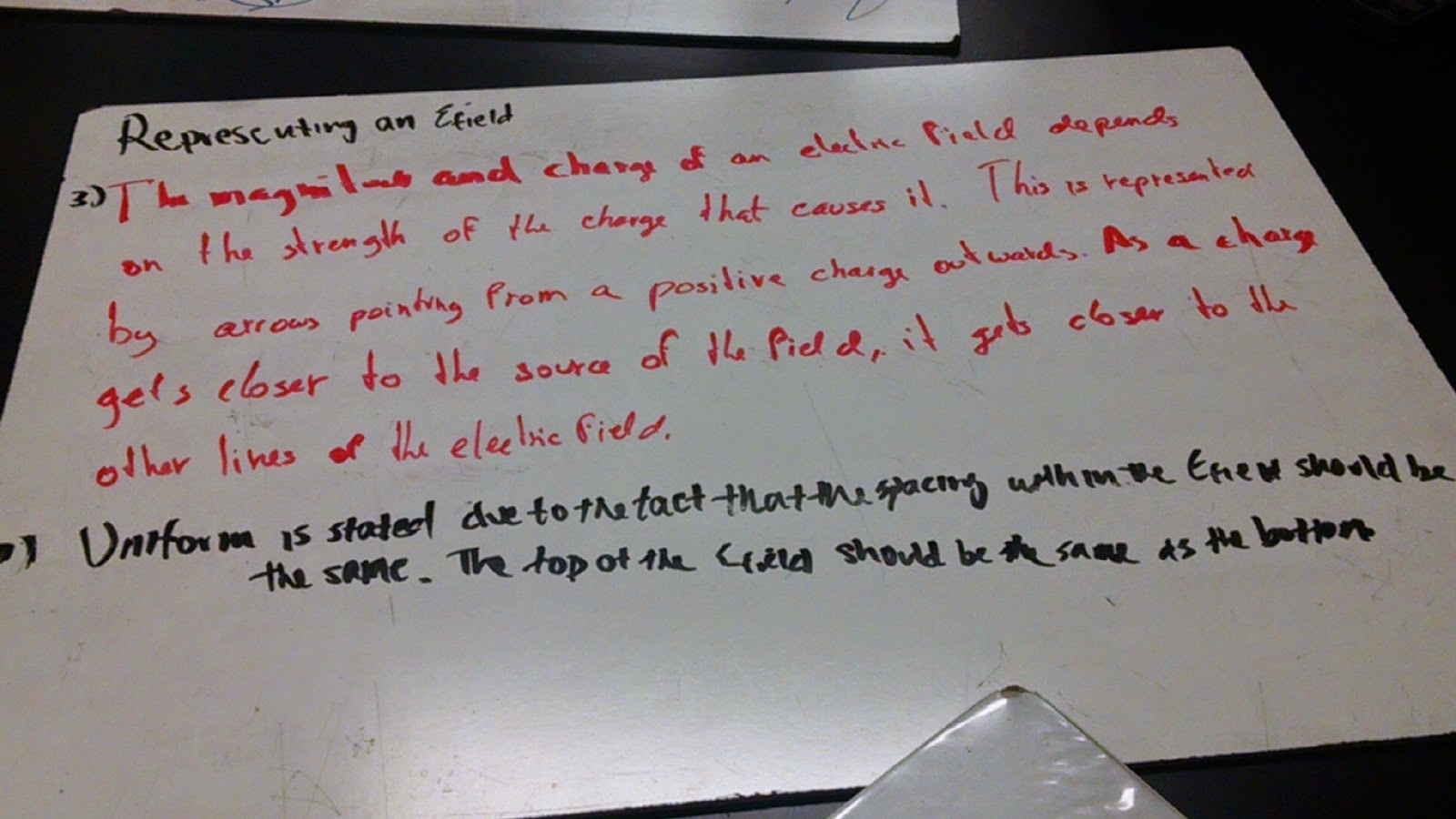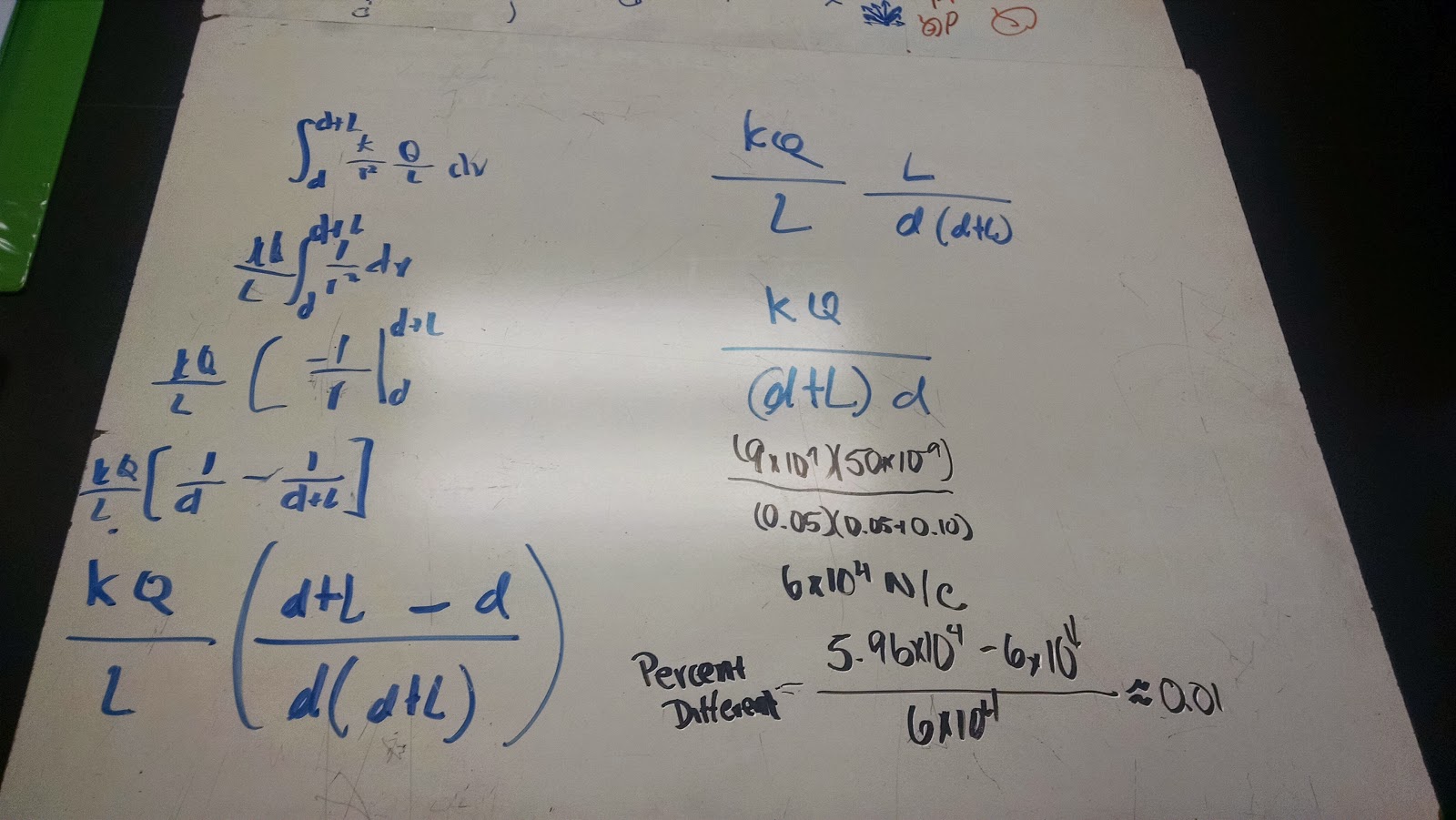Class Discussion - How does Gravity Work:
We started the class by first asking the question "How does gravity work?" As the class struggled to try to answer this, we were shocked when we were told by Prof Mason that scientist, to this day, cannot figure out how gravity works. We then went on to learn about Gravitrons and how these theoretical particles are supposedly the interaction that gravitational force uses, similar to the observed photons that electromagnetic force uses in order to interact.
Electric Field Simulation:
We then went online to answer questions regarding electric field as various positions
 |
| Answers to question 1 and 2 |
 |
| Answers to questions 3 and 4 |
 |
| Representaion of Electric Fields |
 |
| Deriving the newest expression of Electric fields |
We then, after having an understanding of electric fields, were asked to derive it, knowing Coulomb's Law, and the fact that FE = qE
It is to note that we took a slightly different approach to how to find Electric Fields, yet yielding the same answer
Class Discussion- Example Problems
 |
| Solution to the problem |
In order to get a better understanding of superposition of Electric Fields, we took a problem that involved using unit vectors as well.
It is to note that we took the idea of the unit vector, instead of using sines and cosines, realizing that the y-component canceled out, and gave the answer in terms of the x-component
Activity: Eletric Field Vectors from Two Point Charges:
Our next portion of the lab was a bit more challenging, using nothing more than an excel spreadsheets of the electric fields at different distances, we were asked to find the magnitude of the E fields at different positions shown below.
 |
| The points in question |
 |
| Our results of each points |
By using Coulomb's Law and the equation for Electric field, we were able to successfully the magnitude of the electric field, as shown to the far right
It is to note that excel doesn't really like negative numbers, in which is why the last number is in parenthesis, it is actually a negative number
As a mini activity, we were asked to show the configuration of the electrons in both a copper environment and wood environment
In a copper environment, it would create an equatorial triangle, while in a wood environment, it would stay as is.
Once again, we were given a figure, and asked to find the magnitude of its electric field, by only using the excel spreadsheet. This time, it was of a uniformly charged rod ads shown below.
 |
| Our envision of the activity at hand |
We were asked to find the electric field at two different point.
1) 5 cm across from it
2) 5 cm above it perpendicularly
Once again, by using the unit vectors, Coulomb's Law, and the equation for electric field, we were able to find the answer, which is about 5.94x10^-6 N/C
It is to note that if we were to increase the partition from 10 to 20, the answer would become close to about 6 E-6 N/C.
We then learned that another way that it could be solve was by taking the integral, which when we did would lead to be exactly 6 E-6 N/C. We then decided to calculate the percent difference between our answer and the answer that the integral would give us, yielding a 0.01% difference.
Activity- Electric Field Hockey
Our take-home assignment was by looking at a simulation called electric field hockey, in which we are given a positive (or negative, if you wanted to change it) particle, and asked to use the fewest amount of negative and positive charges to send the particle into the goal line. We also learned that via experimentation, the particle cannot bounce off any obstacles, including the walls of the goal line, making the task much more complicated. Below are our solutions to each of the following scenarios along with the amount of charges we thought were required to obtain the GOAL!
Our take-home assignment was by looking at a simulation called electric field hockey, in which we are given a positive (or negative, if you wanted to change it) particle, and asked to use the fewest amount of negative and positive charges to send the particle into the goal line. We also learned that via experimentation, the particle cannot bounce off any obstacles, including the walls of the goal line, making the task much more complicated. Below are our solutions to each of the following scenarios along with the amount of charges we thought were required to obtain the GOAL!
 |
| Level one (6 needed) |
 |
| Level two (3 needed) |
 |
| Level 3 (7 needed) |



No comments:
Post a Comment